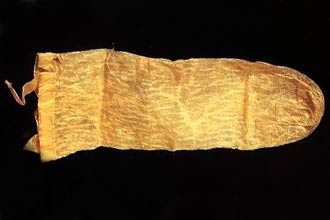The early history of condom use is murky with conjecture and myth. We don’t have much substantial evidence other than some anecdotal evidence and some paintings that show people were using linen, leather or animal intestines as condoms. Our first physical evidence was found in excavations in England and Sweden. Both finds date back to the mid 17th century and are examples of the use of animal intestines for protection. While they may have been used as birth control, they were more than likely used primarily as a barrier against STIs. The 15th century saw a surge of syphilis and gonorrhea infections. It was a growing problem with deadly consequences and was still a concern by the 17th century. Condom use was a way to reduce the spread of disease. They often soaked condoms in a solution that was thought to prevent infection then dried before use. Looser than the condoms of today, they were often tied on with a ribbon. They were also cleaned and reused, something we would never think of doing today.
The 16th century brought us one of the first texts to mention more modern condoms. Italian anatomist Gabriele Fallopio, or Fallopius, treatise De Morbo Gallico (The French Disease) was the first document to mention a condom-like device in 1564, published two years after his death. Fallopio is best known for his namesake the fallopian tubes, but he was also involved in the research and writing of many other important medical discoveries. In this pamphlet, he described a device made out of linen, first soaked in a chemical compound, that would prevent the spread of syphilis. Fallopio states in the text that after clinical trials with over a 1,000 men he concluded that none of them had contracted syphilis.
The 17th century was about the time we start to hear about condoms being used to prevent pregnancy. Most literature about condom use spoke of disease prevention and not pregnancy prevention. You get the first birth control reference in about 1605. Unfortunately, it was written by a Catholic theologian to denounce condoms as immoral due to its contraceptive use. The use of a condom for contraception would come up in a bawdy French novel, L’Escole des Filles, and in a report by the English Birth Rate Commission as a reason for a drop in the fertility rate by the mid-1600s. This fertility rate statistic marks a turning point in our written history as we start to get more straightforward evidence of condom use in reliable documents as well as the first surviving examples of early condoms.
One of these finds is an entirely intact condom found in Lund, Sweden. It is made of pig intestine and is estimated to date back to around 1640. Found along with the condom was an instruction manual written in Latin, also intact. Astonishingly, a translation of the text reveals it recommends washing the condom in warm milk to prevent disease. I’m not exactly sure how warm milk prevents STIs, perhaps it lulls the bacteria to sleep. Early condoms would often be soaked in some sort of preventative solution then dried, but I couldn’t find milk used anywhere else in my research. Not sure why this particular manual decided to recommend it. While milk does have some healing properties, I can’t see how warm milk could be a preventative measure against disease. Early condoms had to be soaked first, usually in water, to make them pliable for use. This instruction sounds like it is supposed to be applied after use when cleaning rather than soaking in it before use.
Another archeological find was at Dudley Castle near Birmingham England. During excavation, the fragments of 10 fish and mammal intestine condoms were found in a cesspit. They were deposited there after being discarded in the garderobe. A garderobe is a medieval latrine that was often also used as a closet since the resulting gasses from being used ostensibly as an indoor outhouse was thought to keep fleas, moths, and other pests away from the garments. These fragments were found after sifting through the remains in the cesspit. They date to about 1642, a time during the English civil war when Dudley castle was often under siege. After repeated attacks by Cromwell’s forces, it was surrendered in 1646 and partially demolished sealing the cesspit. This provided the perfect environment to preserve the condoms. It is thought the condoms were used by the soldiers guarding the castle. Of the ten condoms found, five of them were found layered inside the other.
The struggle for both disease protection and contraception would continue for centuries. From the time of these earliest surviving examples, advancements would be slow. Who used these earliest surviving examples is unknown. It’s often thought that only the rich or the aristocratic could afford to purchase condoms. What about the social station and pocket money of a castle guard? Were fish bladder and animal skin condoms readily available and affordable to everyone? It’s possible that the butchers had enough left over intestines to create new condoms easily. You only need some lye or sulfur to loosen up the intestines. The fact that they were often reused may have made them seem more affordable. There’s not enough written evidence yet to know. We have to look into the next century to get a better idea of how condom use is reflected in the masses.


